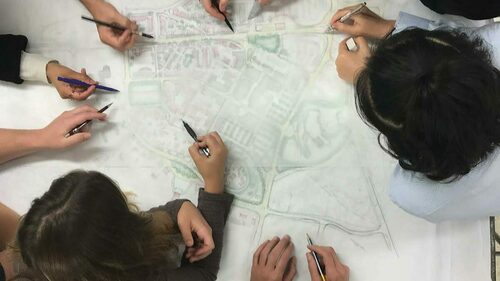
The University of Notre Dame School of Architecture is collaborating with Tesla Inc. to create a design studio course focused on Tesla’s Gigafactory 1 based in Reno, Nevada. Students will explore how to move people and materials through the Gigafactory — the highest-volume battery production facility in the world—while working closely with local government to prepare the Reno area for rapid growth, increase in employment and impact on the region.
Because the Gigafactory is a multi-phase endeavor in which construction and business operations continue simultaneously, architecture students will develop flexible design solutions that account for both temporary and permanent needs.
According to Michael Lykoudis, Francis and Kathleen Rooney Dean of the School of Architecture, the school’s partnership with Tesla is an intuitive match. “Our school is part of a continuum that links timeless principles of traditional urbanism with cutting-edge technology to find solutions for tomorrow’s problems today,” said Lykoudis. “Tesla’s mission to accelerate the world’s transition to sustainable energy pairs naturally with our commitment to the responsible use of resources in service of humanity.”
“At its core, the new design studio is an urban planning exercise because the Gigafactory contains all of the elements of a city: police, fire, public works, offices, restaurants, etc.,” said Marianne Cusato, adjunct associate professor of architecture. “We hope the patterns we explore in this studio will have applications far beyond the course.”
Cusato is spearheading an interdisciplinary team of professors, including Notre Dame College of Engineering’s Jeffrey Kantor, professor of chemical and biomolecular engineering. The design studio students will examine other large structures such as airports and large factories, as well as principles of urban planning, to suggest patterns of growth for moving people and materials through the facility that make sense at all levels of completion — from opening the first production line to operating at full capacity.
“We are excited to collaborate with the students and faculty at Notre Dame,” said Pete Rusin, project architect at Gigafactory 1. “A university setting allows us to look at our processes through a new lens while at the same time inspiring the next generation of innovators.”
The second phase of the project will address how a business can work efficiently with local municipalities to prepare for rapid expansion. While there are currently 7,000 employees at the Gigafactory, the facility is only 30 percent complete. As Tesla ramps up battery production and continues to build out the factory, the Reno-Sparks area can expect 10,000 new residents each year. Students will help identify economic development opportunities to present to the city, proposing how to expand affordable housing and other infrastructure to accommodate the influx of people and new businesses.
The course will take place in the spring 2019 semester, concluding with student presentations to Tesla management and Notre Dame faculty.
Contact: Amanda Skofstad, assistant director of media relations, 574-631-4313, skofstad@nd.edu